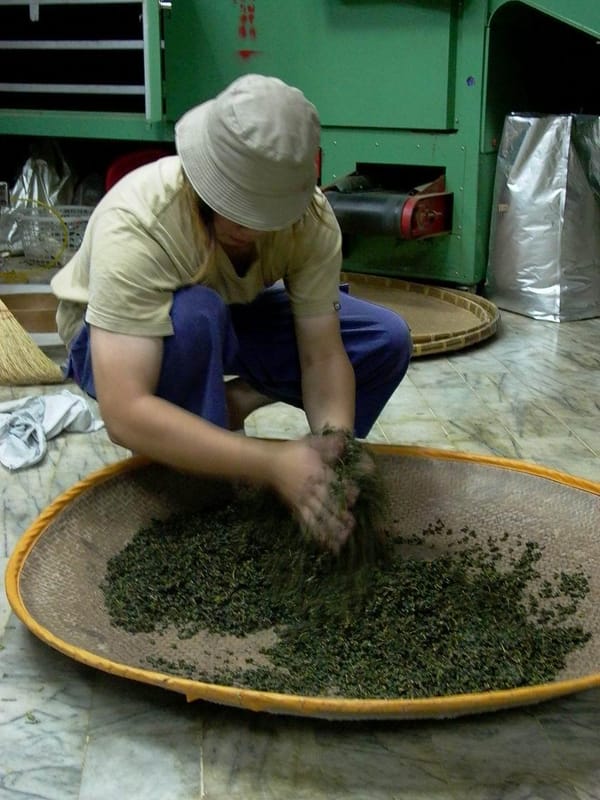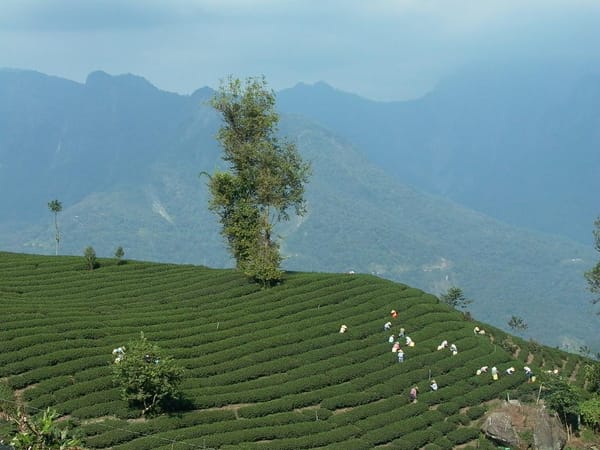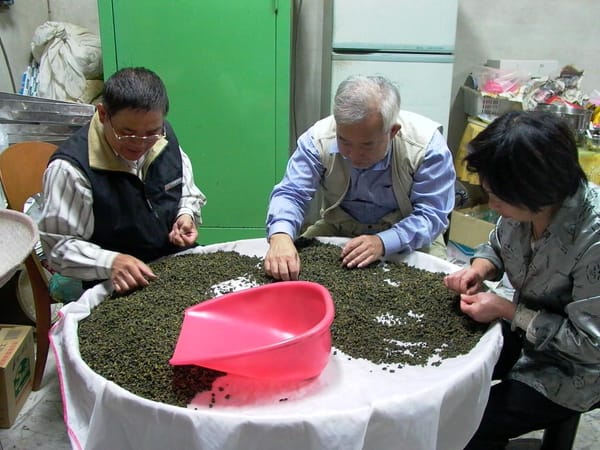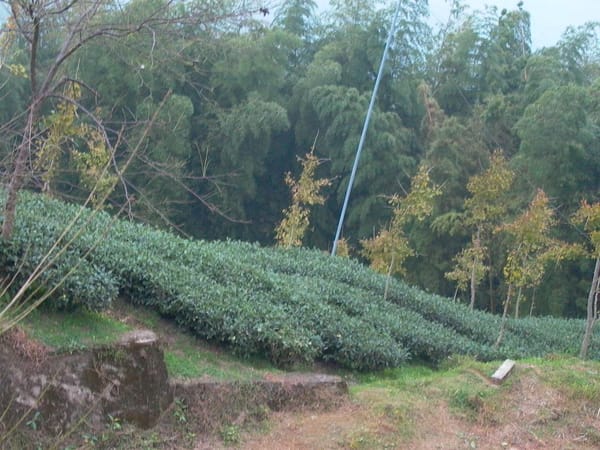When you gently touch a tightly rolled semi-ball of oolong tea, have you ever considered the generations of craftsmanship that made this form possible? From a serendipitous discovery in the Fujian mountains during the 17th century to the precise techniques of today, the evolution of oolong tea processing is a story of dedication, tradition, and innovation.
This is a tale of technological inheritance and breakthrough—an embodiment of the constant refinement in Eastern tea-making craftsmanship. Traditional “covered firing and ball rolling” created the unique semi-ball shape of oolong tea, while modern precision techniques aim for greater consistency and quality.
Let’s journey through time and explore how oolong tea-making evolved—from ancient methods to modern innovation—and uncover the deeper reasons behind each technical change.
Origins of Oolong Tea Processing
The invention of oolong tea marked a revolutionary advancement in tea processing, transitioning from green tea toward semi-fermented “qingcha” (blue-green tea). Historical records trace this breakthrough to 17th-century Fujian, where tea farmers accidentally discovered the secret of semi-fermentation during green tea production.
In 1717, county magistrate Lu Tingcan of Chong’an documented in “Continued Classic of Tea” a quote from Wang Caotang’s “Tea Theory,” preserving one of the earliest records of oolong tea processing: “Wuyi tea is harvested between Grain Rain and the Start of Summer. After plucking, the leaves are spread in bamboo baskets and sun-dried in the wind—this is called shaiqing. Once the green color fades, the leaves undergo both pan-firing and roasting.”
This dual process of “pan-firing and roasting” distinguishes oolong tea from other types. “When brewed, the tea appears half-green and half-red. The green comes from pan-firing; the red, from roasting.” This characteristic “half-green, half-red” appearance defines oolong tea’s visual and flavor identity.
Essence of Traditional Covered Firing and Ball Rolling
Among traditional oolong tea processes, “covered firing and ball rolling” represents its most distinctive core technique. These steps not only shape the iconic semi-ball form but also drive key chemical transformations within the leaves.
Covered firing involves pan-frying tea under a closed lid, creating a semi-sealed environment that promotes controlled heat reactions. This method preserves moisture, enhances transformation of inner compounds, and protects aromatic volatiles from dissipating.
Ball rolling is essential for shaping. After pan-firing, tea leaves are wrapped in cloth and tightly kneaded into spherical clusters. Through repeated pressing and twisting, the leaves form a compact shape. But this step is more than aesthetics—it activates internal fermentation.
As cell walls rupture, tea juices redistribute, creating the signature “green leaf with red edges.” The mechanical pressure also fosters partial oxidation, enriching aroma and complexity.
Changing Fermentation Levels Over Time
Traditional oolong teas were highly fermented, typically between 15–30%. This heavier oxidation yielded golden liquor, dominated by rich fruity aroma and a full, mellow body.
In Ruan Minxi’s “Wuyi Tea Song,” he wrote: “With calm heart and skillful hands, mastery lies in controlling the fire,” emphasizing how artisans relied on experience to judge fermentation levels and roasting timing.
This high fermentation gave traditional oolongs both the depth of black tea and the freshness of green tea. As tea scholar Chen Chuan put it, “Qingcha combines the merits of black and green teas—black tea’s color and aroma, green tea’s refreshing sharpness, but without the bitterness or astringency.”
The Precision of Modern Processing
With advances in technology and shifting consumer preferences, modern oolong tea production underwent significant changes. Most notably, fermentation levels dropped dramatically—from 15–30% to just 8–12%.
This shift altered the liquor color from golden to honey green. Fragrance transitioned from bold fruit notes to delicate floral tones. Modern drinkers increasingly favor this lighter, more elegant profile, prompting refinements in processing.
Improved Withering Techniques: Controlled environments now regulate temperature and humidity in withering rooms. Unlike traditional sun or indoor withering, artificial withering yields more consistent results.
Precision Fermentation Control: Replacing instinct with sensors, modern processing allows real-time monitoring of fermentation via temperature, humidity, and airflow—ensuring repeatable quality.
Mechanization: Machines now assist every step—rolling, tossing, drying—improving efficiency and product uniformity.
Taiwan’s Innovations in Oolong Processing
Taiwan has pioneered its own path in oolong production. As plantations climbed from 600 to over 1,000 meters above sea level, processing methods adapted to high-mountain conditions.
Light Withering: High-mountain environments, with cool temperatures and mist, naturally endow tea with rich compounds. Lighter withering retains these delicate characteristics.
Low-Fermentation Style: To complement light withering, Taiwan oolong often uses light oxidation, enhancing floral notes and yielding Taiwan's signature elegant flavor.
Fine-Graded Standards: Taiwan introduced meticulous grading systems, from Extra High, High, Medium, to Standard, each with defined criteria and technical requirements.
Harmonizing Cultivar and Technique
To match evolving processing methods, Taiwan’s tea breeders selected optimal cultivars. “Qingxin Oolong” emerged as the gold standard for semi-oxidized teas.
New hybrids like TTES #12 (Jin Xuan) and TTES #13 (Tsui Yu), developed by Taiwan’s Tea Research and Extension Station, were tailored to modern low-fermentation needs—producing excellent flavor under Taiwan’s unique climate.
Scientific Quality Evaluation
Modern tea-making incorporates scientific analysis. Chemical composition, nutrient testing, and sensory standards now guide quality control.
Components like polyphenols, amino acids, caffeine, and water-solubles are quantified through precision instruments. These data inform both evaluation and further process optimization.
Sustainability in Tea Craft
Sustainability is now a guiding principle in tea production. Eco-friendly practices such as organic farming, solar drying, and rainwater harvesting are gaining traction—ensuring both quality and environmental care.
Blending Tradition with Innovation
Despite modern improvements, the soul of traditional craftsmanship persists. Many artisans continue to uphold the philosophy and standards of ancient methods even when aided by machines.
This blend of old and new preserves cultural depth while achieving technical precision. Each step in oolong tea processing embodies a dialogue between heritage and innovation.
Ancient vs. Modern Oolong Tea Craft
From covered firing and ball rolling to high-tech precision, the evolution of oolong tea reflects humanity’s enduring pursuit of excellence. By fusing ancient wisdom with modern methods, oolong teas today offer a diverse range of flavor experiences.
These advancements bring greater consistency, quality, and versatility—meeting diverse global tastes. Whether rich and fruity or light and floral, each style tells a story of culture and craftsmanship.
So the next time you sip an elegantly processed oolong, remember the centuries of ingenuity in every cup. This tea is not just a beverage—it’s a living chronicle of innovation and tradition.





